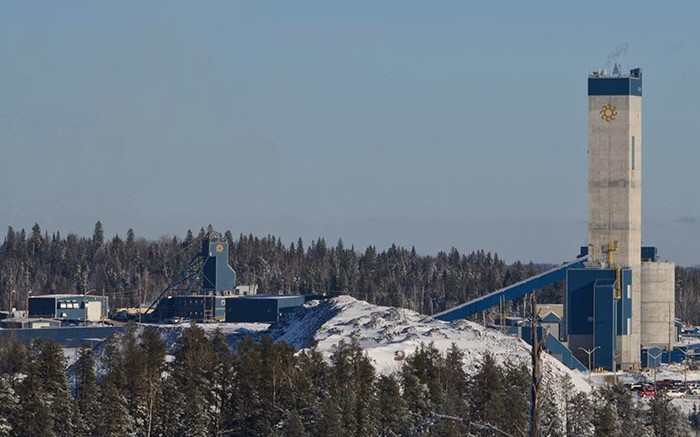VANCOUVER — Alamos Gold (TSX: AGI; NYSE: AGI) and AuRico Gold (TSX: AUQ; NYSE: AUQ) have apparently been in an on-again, off-again courtship for years, but on April 13 the companies decided to tie the knot amidst a rising tide of merger and acquisition activity in the gold space. The friendly deal would create a diversified North American gold miner with three producing assets, ample cash and a US$1.5-billion market capitalization.
Alamos president and CEO John McCluskey recounted during a conference call that he had initially spoken with AuRico president and CEO Scott Perry about a business combination around two years ago. The negotiations didn’t pick up steam until mid-January.
The timing and market conditions for the deal appear ideal, as the two companies’ market valuations were nearly identical at the time of the merger, and each brings different strengths to the table.
AuRico offers up a cornerstone, long-life asset in the form of its Young-Davidson gold mine in northern Ontario’s portion of the Abitibi greenstone belt, but the company is sitting on over US$300 million in debt. Alamos, on the other hand, boasts an impressive cash position, with US$400 million in working capital, and was looking to add a long-life North American gold mine to its portfolio.
The new company will have three operating mines in North America and a selection of development projects in North America and Turkey. Under the all-share deal, former Alamos and AuRico shareholders would each own half of the vehicle, which would retain the Alamos Gold name.
“Our teams have worked really hard to construct this deal as an ‘at-market’ merger of equals. It’s something we view as a transformational, win-win construct for everyone involved,” Perry commented.
McLuskey, who will continue to serve as CEO, added: “I think the key is that we’re creating a larger, more diversified gold company with three producing mines in safe jurisdictions, and a really strong growth pipeline comprised of projects with low capital intensity. We have a healthy balance sheet to support this growth, and we expect strong cash flows from our two flagship projects over the coming years. We believe it will be one of the most attractive vehicles amongst the intermediate gold producers.”
Alamos’ two primary production assets will be Young-Davidson and the Mulatos heap-leach mine in Sonora, Mexico, which has proven and probable reserves of 47 million tonnes grading 1.16 grams gold for 1.7 million contained oz. McCluskey said that Young-Davidson will be the company’s flagship operation, and mentioned that Alamos had been looking for “a good-quality, long-life Canadian gold asset for quite some time.”
Young-Davidson has a reserve life of 15 years based on 45.3 million proven and probable tonnes grading 2.63 grams gold per tonne for 3.8 million contained oz. McLuskey pointed out, however, that given the good exploration potential, and the long-life nature of underground operations in the Abitibi, the company expects the mine will run for at least another 20 years.
The merged company’s production in 2015 is expected to range from 375,000 to 425,000 oz. gold, and Alamos figures it can “grow organically” to over 700,000 oz. annual gold production by 2018. Mid-term growth is expected to come from the Kirazl and Ag Dag open-pit, heap-leach projects in Turkey, though the company remains in court over its environmental permits.
A company to be named AuRico Metals would be spun-out and contain non-core assets. Current AuRico and Alamos shareholders will equally split ownership of the new company. The big-ticket item in the spin-out would be the Kemess underground copper-gold project, 430 km northwest of Prince George, B.C. The vehicle would also have US$20 million in cash, a 1.5% net smelter return royalty on Young-Davidson and royalties on the Fosterville and Stawell mines in Australia.
Alamos has also agreed to subscribe to a private placement in AuRico, wherein it will buy 28 million shares at US$2.99 per share for gross proceeds of US$83 million. The placement is a bit of an oddity considering the pending merger, but it will give Alamos a 10% equity stake in AuRico, which could dissuade competing bids and give the companies more deal security.
“We’re in the mining business and the view I’ve always held is that gold is a scarce commodity, and you need the expertise to mine it when you find it. I think our combined management strength gives us the expertise to operate and develop a variety of mines, and that creates a tremendous optionality for future growth,” McCluskey continued.
“In the world we live in, political risk is a growing concern for investors. We’ll have one of the best risk profiles in the industry following this merger. And in terms of growth, we really think there are very few companies that can match what we’ll be offering to shareholders,” he added.
Shares of Alamos rose 6.6%, or 31¢, en route to $4.09 close, and Aurico shares jumped 8.2%, or 49¢, before closing at $7.90 at press time. The companies see the merger creating synergies worth US$10 million a year at mines and Toronto head offices. After the merger Alamos should have 255 million shares outstanding.
BMO Capital Markets analyst Brian Quast noted that “the company will vault into solid intermediate” if the deal closes. BMO Research rates Alamos as “outperform,” and boosted its price target by $1 to $10.25 per share.
“Young-Davidson is the jewel of the AuRico assets, with a long mine life and steady growth over the next two years as the mine ramps up to full production by the end of 2016,” Quast added in an April 14 research note. “BMO Research views the potential of an interloper bid as low, given the meaningful termination fees, pending private placement by Alamos in AuRico shares and lack of well-capitalized suitors.”


Be the first to comment on "Alamos, AuRico unveil US$1.5B ‘merger of equals’"